Rubar Plants.
Rhubarb (Rheum rhabarbarum) is a hardy, perennial vegetable known for its tart stalks and unique flavor. It's commonly grown for its culinary uses, especially in pies and preserves. Here’s a detailed overview of rhubarb plants:
Description:
- Botanical Name: Rheum rhabarbarum
- Common Names: Rhubarb
- Appearance: Rhubarb plants have large, broad, heart-shaped leaves and thick, fleshy stalks (petioles) that can be green, red, or a combination of both. The edible part of the plant is the stalk, while the leaves are toxic and should not be consumed.
Growing Conditions:
- Climate: Rhubarb is best suited to temperate climates with cool to cold winters and mild summers. It requires a winter chilling period to produce quality stalks. It thrives in temperatures between 7°C and 24°C (45°F to 75°F).
- Soil: Rhubarb prefers well-drained, fertile soils rich in organic matter. The soil should be slightly acidic to neutral, with a pH of 6.0 to 7.0. Heavy clay soils should be avoided or amended to improve drainage.
- Watering: Rhubarb needs consistent moisture, particularly during the growing season. Regular watering helps ensure healthy stalk development. Avoid waterlogging, as it can lead to root rot.
Cultivation:
- Propagation: Rhubarb is typically propagated through division of established crowns or from seed. Division is done by separating the crowns into smaller sections, each with at least one bud. Seed propagation is less common and can take longer to produce mature plants.
- Planting: Plant rhubarb crowns in early spring or late fall. Space plants about 90 cm to 1.2 meters (3-4 feet) apart to allow for their spread. Planting is usually done in well-prepared soil, and crowns should be planted just below the soil surface.
- Maintenance: Regularly remove weeds and mulch around the base of the plant to conserve moisture and suppress weeds. Rhubarb benefits from annual applications of compost or well-rotted manure to replenish soil nutrients.
Uses:
- Culinary Uses: Rhubarb stalks are used in cooking and baking, often in pies, tarts, crisps, and jams. Its tart flavor pairs well with sweet ingredients, making it a popular choice for desserts. Rhubarb can also be used in savory dishes and sauces.
- Medicinal Uses: In traditional medicine, rhubarb has been used for its digestive benefits and as a mild laxative. However, its medicinal uses should be approached with caution, as the leaves are toxic.
Cultivation Tips:
- Pests/Diseases: Rhubarb can be affected by pests such as aphids, slugs, and snails. Fungal diseases like crown rot and leaf spot can also occur. Regular monitoring and appropriate treatments are essential.
- Fertilization: Rhubarb benefits from regular fertilization, particularly with compost or well-rotted manure. Fertilizer applications should be made in early spring to support vigorous growth.
- Harvesting: Harvest rhubarb stalks when they are mature, firm, and at least 25 cm (10 inches) long. Pull the stalks gently from the plant, twisting them slightly. Avoid harvesting more than one-third of the plant at a time to allow for continued growth. Do not eat the leaves, as they contain toxic compounds.
Economic Importance:
- Rhubarb is valued in both local and commercial markets for its unique flavor and versatility in cooking. It is grown in various regions with suitable climates, including parts of North America, Europe, and Asia.
Rhubarb is a versatile plant with a distinct flavor, making it a popular choice for home gardeners and commercial growers alike. If you have any more questions about growing or caring for rhubarb, feel free to ask!


